No products in the cart.
Thursday, July 25, 2024
Break Office Chair Addictions & Find Comfort In ANY Chair
When you buy something using an affiliate link in this post, ChairsFX may receive a small commission, at no additional expense to you. This has no influence on our editorial content. See our Affiliate Disclosure for details.
Reading Time: 15 mins read
Reddit’s r/OfficeChairs and r/HermanMiller are teeming with ergonomic office chair addicts. They buy multiple high-end chairs in pursuit of undefined ‘good ergonomics’ — but never find satisfaction. This is unnecessary and counter-productive. Learn about high-end office chair addictions — and the psychological compulsions that power them. Then, discover how to break through these to easily find perfect comfort in any fully-ergonomic chair.
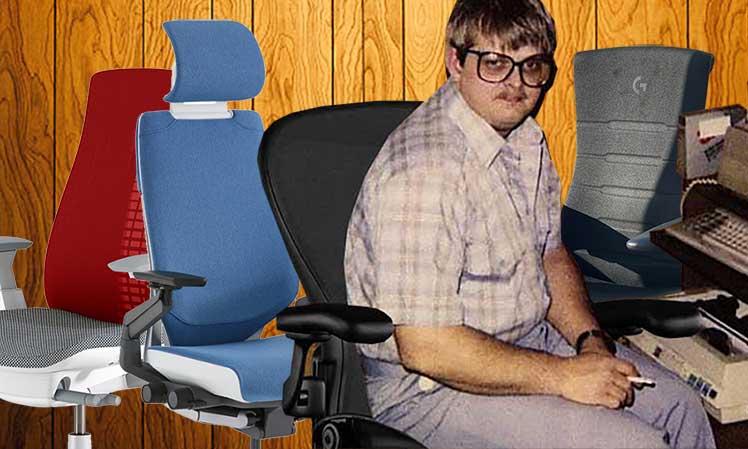
All ergonomic chairs have the same end goal: to hrlp users sit in neutral sitting postures. To support those, all ergonomic chairs come with three adjustable features. Adjustable lumbar support aligns the lower spine.

Adjustable armrests provide extra bracing to hold the torso up against gravity. A reclining backrest lets a seated body move. Adjusted to suit your size, these support neutral sitting postures.
I’ve tested hundreds of different gaming chairs and office chairs using my 5’9″ size. Assuming the right chair fit — and the necessary trio of components — I can enjoy good back support in any ergonomic chair. Here’s an example:
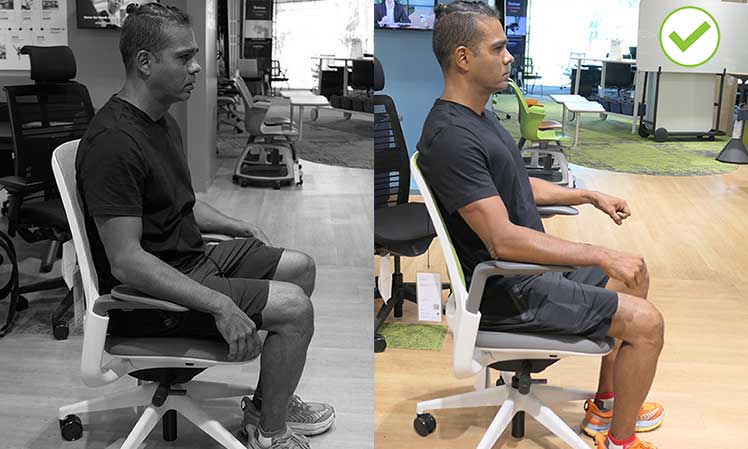
In the first image, I’m using a Steelcase Series 1 without making the proper chair adjustments — my posture looks awful! But instead of blaming the chair, I adjusted the seat height, armrests, and lumbar support. You can see the result in the second picture.
How To Sit In An Ergonomic Chair: Step-By-Step For Beginners
Other ergonomic chair users handle postural issues differently. Instead of fine-tuning their sitting methods, they ditch the chair, buy a new one, and try their luck again. Keep reading if you’d like to avoid that happening to yourself.
Reddit Office Chair Addict Examples
Most people don’t know that ‘comfort’ includes both physical and psychological factors. The former is an absence of discomfort. The latter is a wide array of glittery trappings that appeal to the psyche. These include headrests, fancy tilt functions, and flashy chair skins.

Some people get so lost in the lights of psychological gimmicks that they lose sight of the original back support purpose. For example, Reddit’s r/OfficeChairs and r/HermanMiller forums are popular among hard-core office chair addicts.
Many buy multiple high-end chairs costing thousands of dollars — but never find satisfaction. Find below two office chair addiction cases culled from those forums:
u/LAdude Hates All Chairs
u/LAdude54 has chronic back problems. He used an Office Depot Quantum 9000 for a few years but found the seat too slippery. Then he started splurging on high-end chairs.
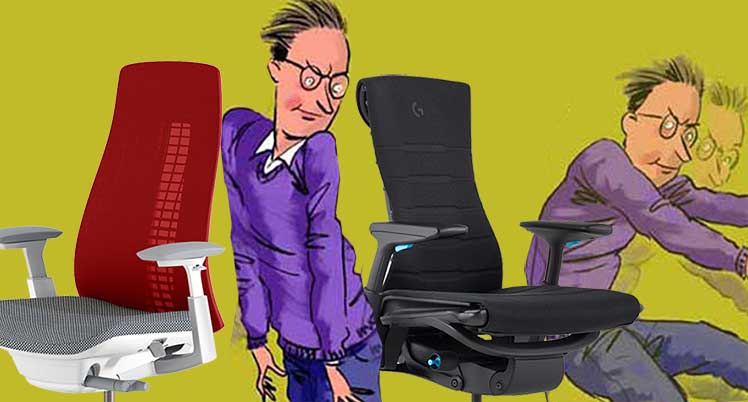
A timeline of u/LAdude54’s pricey misadventures:
- Embody ($1695+): did not understand the back support concept before buying. Was ‘shocked’ when he learned how it worked. So he ordered an Aeron.
- Aeron ($1400+): did not understand the ‘strange’ mesh support concept before buying. “It caused me to slouch.” Still not happy, he next bought a Haworth Fern.
- Fern ($1600+): firm seat and a weird backrest that “caused me to slouch”.
After buying all three chairs, he learned how the Embody chair’s Backfit system works. So he returned the Aeron and Fern chairs. But once his 45-day return policy guarantee expired, he decided that he hated his Embody.
I’ve reached the worst possible destination – an almost unusable chair bought at a premium price.u/LAdude54
u/micromushe On A Never Ending Hunt
u/micromushe started his ergonomic chair hunt in 2021. Since then, he’s bought six different ergonomic office chairs — but remains unsatisfied.
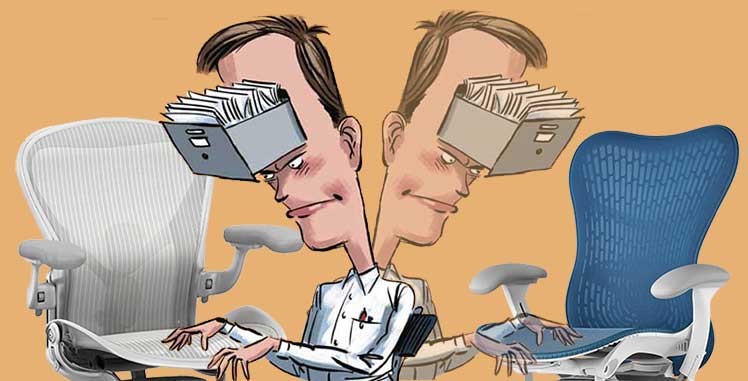
Here’s a summary of his dislikes with each chair tried:
- Steelcase Please: the armrests caused pinky and elbow pain.
- Steelcase Leap: the lumbar support was too aggressive.
- Hag Capisco: squeezed his testicles.
- Herman Miller Mirra 2: could not find a comfortable armrest position.
- Herman Miller Embody: does not fit “my weird back”.
- Haworth Fern: makes him slouch; causes indigestion.
After two years, thousands of dollars, u/micromushe is still cruising message boards, fishing for chair recommendations with the vague requirements of a pure beginner:
The most important things for me would be mesh or similarly flexible material… should be ergonomic… tilt limiter highly preferred…u/micromushe
Ergonomic Seating Realities
The biggest mistake that ergo office chair fanatics make is lack of a clear objective. In reality, all ergonomic chairs are designed to do the exact same thing: support neutral postures.

Do you know how it feels to sit in a neutral posture for long periods? If yes, you can assess the potential of a chair objectively.
Without internalizing neutral postures (with practice), office chair addicts set themselves up for failure. They seek ‘ergonomic’ perfection — with no understanding of what that entails.
Here are the fundamentals that every ergonomic chair buyer should know:
- Neutral posture objective: the end goal, regardless of chair. Mastering this technique makes ANY chair usable.
- Components trio: all ergo chairs support neutral postures using the same 3 components (it’s not complicated).
- Cheap chairs for beginners: don’t overspend on complex chairs until you know what you’re doing. Cheap, simple chairs work well for first-time ergo chair users.
- Pain isn’t chair-related: improper usage is typically the cause — not the chair. Buying more chairs won’t help.
ALL Chairs Support Neutral Postures
Without support, a seated lower back flattens. All ergonomic chairs are designed to prevent that by supporting neutral sitting positions.
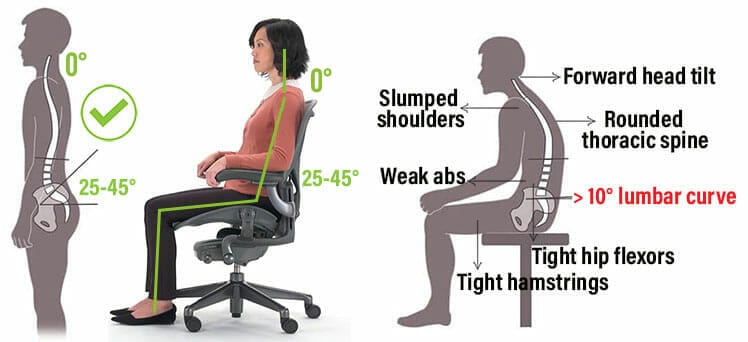
Neutral postures align the seated spine as if it was in a healthy standing position. The textbook posture includes a 0° neck tilt and a 25-45° lower back curve.
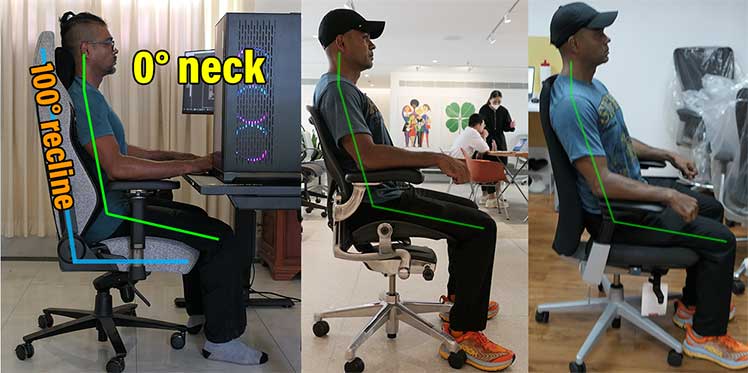
It doesn’t matter what type of ergonomic chair you use. Any model with the requisite ergonomic features can provide the support you need. This clip shows the gist in a Secretlab Titan and Herman Miller Aeron:
Anyone can master neutral sitting techniques easily — using either a gaming or ergonomic office chair — using this guide:
Neutral Posture QuickStart: For Gaming AND Office Chairs
Neutral Postures Powered By NASA
The science of healthy sitting pre-dates the ergonomic seating industry. NASA discovered these positions in outer space in 1973.
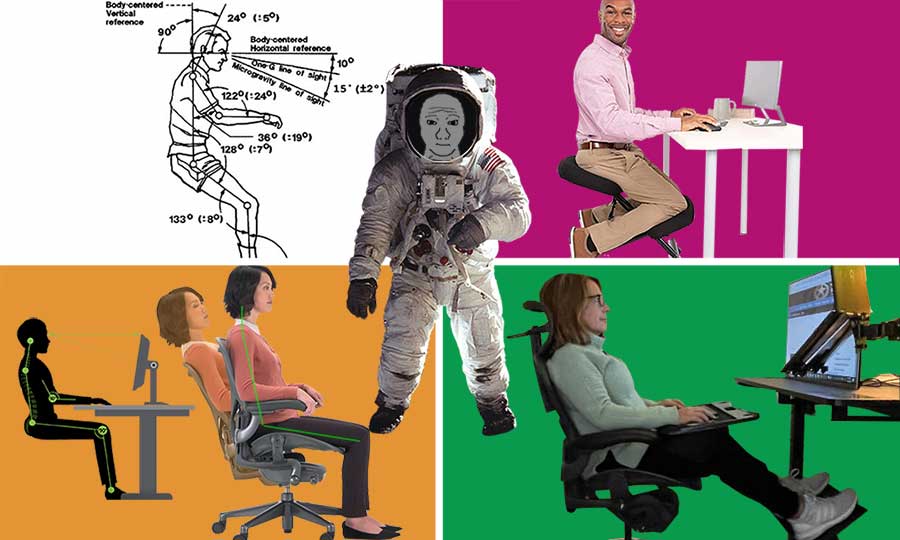
When relaxing or working, astronauts in zero gravity instinctively fell into these postures. These align the spine to work with maximum efficiency.
Neutral Support Has 3 Components
OSHA, BIFMA, The Handbook Of Human Factors & Ergonomics and many other institutional experts agree. To qualify as ‘ergonomic’, a chair needs three components:

In all cases, these components support neutral sitting in the same ways:
- Adjustable lumbar: maintains a healthy lower back curve.
- Adjustable arms: extra bracing to hold the torso up against gravity; absorbs limb weight.
- Reclining backrest: lets you customize support angles and move while sitting.
In all cases, you’ll need to make the right adjustments for best results. The most important adjustment is the lumbar support.
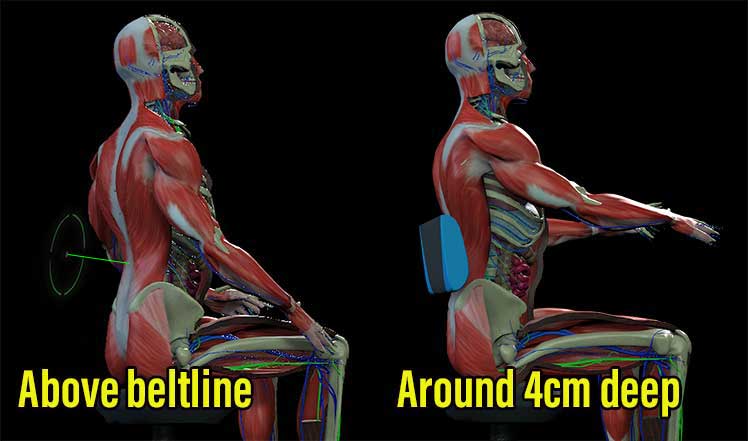
The textbook lumbar support target is around 4 cm deep, placed slightly above the beltline.
Beyond lumbar support, you’ll want to adjust your seat height and backrest recline angle for best results. Follow these targets:
- Lumbar support: 4 cm deep, placed slightly above the beltline.
- Seat height: raise the height to angle your hips slightly higher than your knees.
- Backrest recline: a 100° recline yields a sharp upright posture; a 110° recline is a more relaxed variation. Toggling between the two is ideal.
Mini-Case Study: Steelcase Series 1
I recently tested the importance of proper chair settings using a Steelcase Series 1. First, I tried to sit with good posture — with the seat, armrests, and lumbar support all set too low.
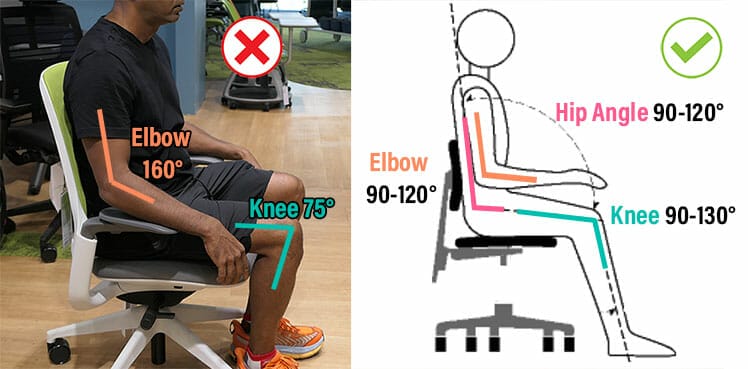
Then, I adjusted the chair to suit my body type using the three listed adjustments. You can see the difference that proper adjustments make for yourself.

Bottom line: if your chair’s support seems off, do not panic-buy another pricey chair! Instead, take a deep breath, check your chair’s settings, and aim for a neutral posture. Learn more:
Beginners Should Start Simply
Little kids learn how to ride bikes using training wheels. When they get older, they can level up to a BMX and learn stunts. With enough practice and maturity, they’ll one day be ready to level up to a power bike.
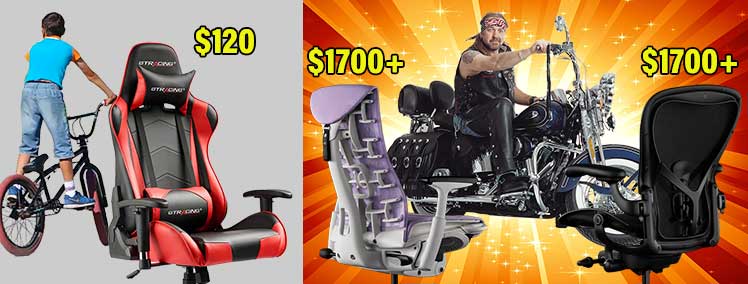
In a similar fashion, a beginner starting out with a world-class ergo chair is asking for trouble. Without any experience actually working in neutral postures, you’ll have no points of reference if things go wrong.
Herman Miller Embody
The Herman Miller Embody is one of the world’s most advanced chairs. It’s also one of the worst picks for ergonomic beginners. Without a firm grasp of its controls and purpose, it’s almost impossible to find a supportive fit.
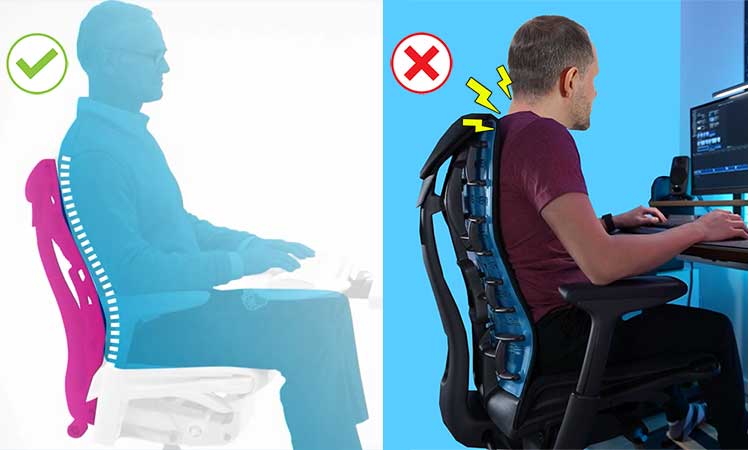
If you’ve never maintained neutral sitting postures before, the Embody’s concept will be tricky to grasp. Its Backfit support system is not height-adjustable — you can only toggle the angle of the top or bottom portion of the backrest.
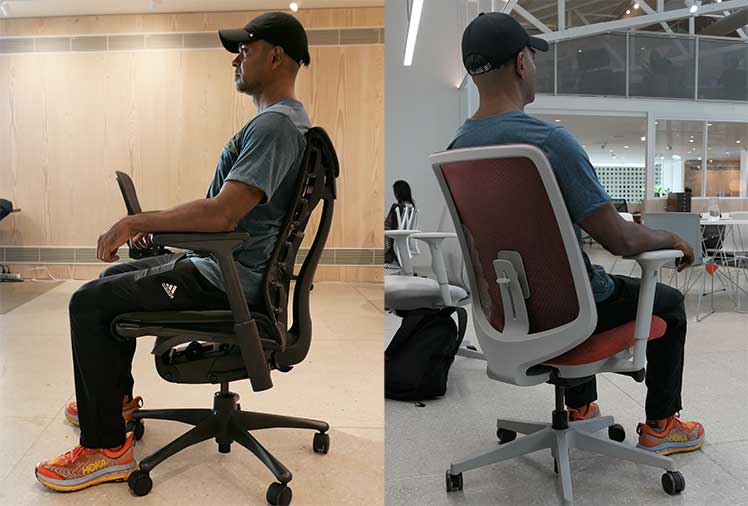
The point is to toggle the Backfit so that it cups your upper back curve. That cupping will ‘suspend’ your entire spine into a good posture. But there’s a catch. When sitting in any chair, the lower back curve flattens.
Even though it supports an overall good posture, the Embody’s support is lumbar-less. As a result, your lower back curve almost totally flattens when sitting upright.
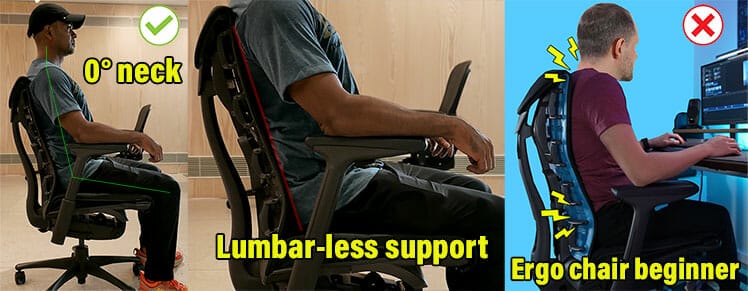
Bottom line: Backfit angles, spinal suspension, and lumbar-less support are advanced concepts. If you have no experience with ergonomic chairs, get some before messing with power user chairs!
Embody Gaming Chair From Herman Miller $1695
Learn more: Embody Gaming Chair Review
Cheap Chairs For Beginners
If you’ve never used a fully-ergonomic chair before, starting off with a complex, pricey, world-class chair is foolish. You’re taking a big financial risk by spending more — for the same neutral posture support as a cheap chair. Why?
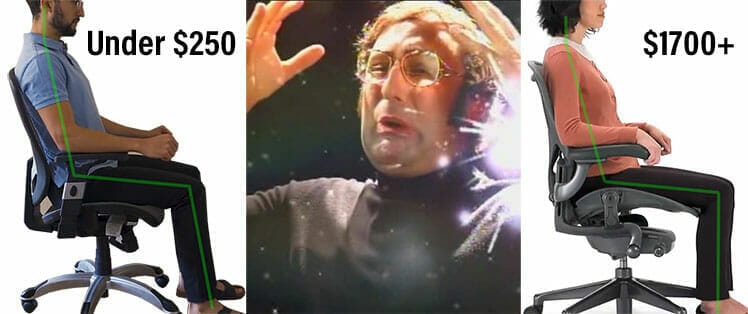
A neutral sitting posture is finite — it doesn’t get better when you spend more money. Instead, spending more on a pricey Herman Miller will get you a 12-year warranty — and some psychological luxuries.
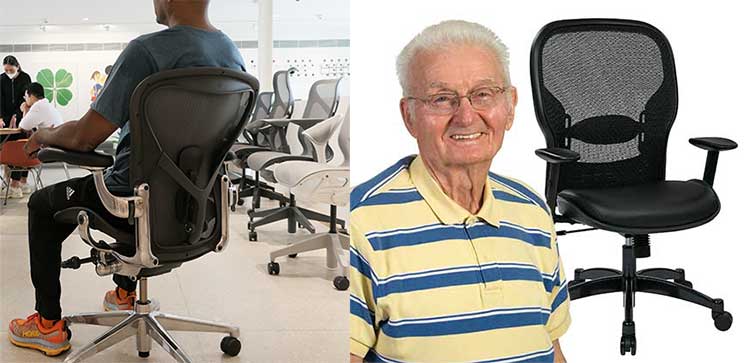
These extras do not improve the back support of a chair. Instead, they make the experience more luscious and decadent. Expect fancier upholsteries, more complex parts, and super-sweet aesthetics.
For these reasons, a cheap ergonomic chair is absolutely worth it for ergonomic first-timers. In the big picture, it doesn’t matter if you choose a gaming chair or office chair.

Choose whichever fully-ergonomic style that feels right. Then, make an effort to use it correctly. In less than a week, you can internalize neutral postures. Then, any chair with the right adjustments can do exactly what you need it to.
Best cheap chairs: Gaming Chairs Under $200 | Ergo Office Chairs Under $350
Switching Chairs Doesn’t Fix Pain
Any chair with the requisite adjustable components can provide the neutral support that you need. If back pain arises, the first logical remedy is to revert back to a sharp, textbook neutral posture.
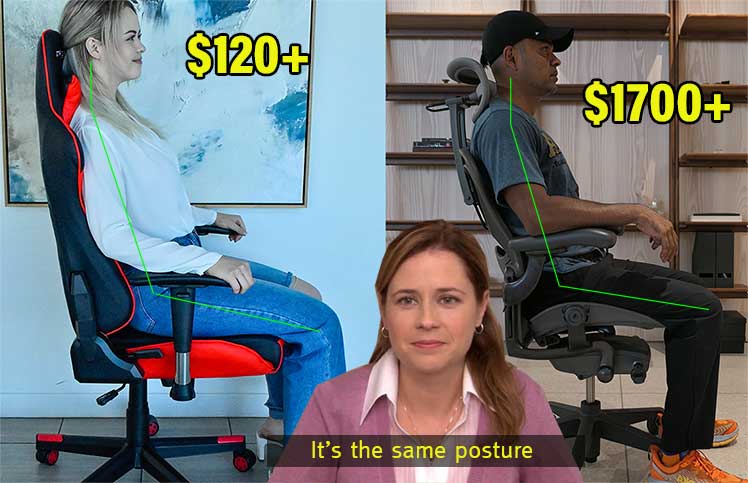
If you don’t know how to maintain a sharp neutral posture, that’s your problem — not the chair. Spend 10 minutes using our Neutral Posture Starter’s Guide. Then, spend a few days maintaining neutral postures. Once those set in your muscle memory, you can relax pain-free.

From a professional troubleshooting perspective, your chair is also the last option for pain relief. Advice to ChairsFX readers from Dr. William Duncan:
Postural issues typically arise from poor strength and endurance in the postural muscles — not the type of chair someone uses. A chair alone cannot fix your issues. If you work on strength & endurance and use a good chair, this will most likely resolve the source of your symptoms and allow you to play longer.Dr. William Duncan
What Fuels Office Chair Addictions?
Why do some people buy multiple high-end chairs — but never find satisfaction? It’s possible that some simply enjoy collecting office chairs the way others collect Barbie dolls.

But it’s also possible that there are underlying psychological reasons. Here are three to consider:
- Dopamine addiction: trained monkey tests shed light on the thrill of buying a high-end chair.
- Chaos addiction: neutral postures eliminate physical & mental distractions (chaos addict crutches).
- Pressure anxiety: without distractions, your workload burden can spark jarring anxiety.
Dopamine Addiction
Buying a high-end office chair can be a thrilling experience. First, you can enjoy a wave of attention from office chair peddlers in Reddit’s r/OfficeChairs and r/HermanMiller forums. They’ll make you feel like a VIP with plenty of attention and detailed answers.

Once you buy from any of the big brands (Herman Miller, Steelcase, etc), they’ll treat you like a high-powered executive with the finest taste.

If you order from Herman Miller, they’ll even send a delivery person with white gloves to unbox your chair. Through the entire research, buying, and delivery process, you’ll feel like a princess!
Shopping, Dopamine, and Anticipation
Robert Sapolsky tested dopamine effects on the brain using trained monkeys(1). He learned that rewards don’t boost dopamine — the anticipation of a reward does.
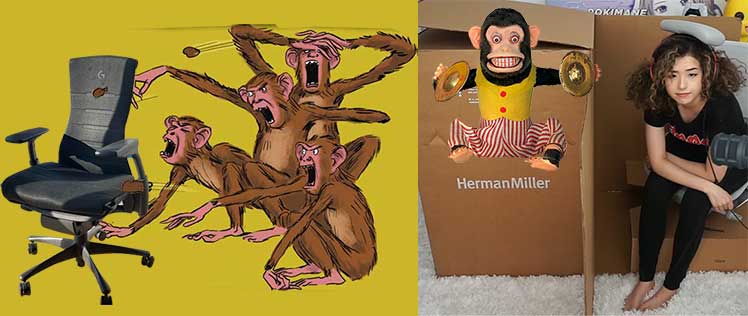
He also found that unpredictability increases the dopamine hit. This explains the thrill of buying a high-end chair — without knowing what it actually does.
- Researching online creates the thrill of the hunt.
- Ordering a chair online jacks dopamine with the anticipation of a reward.
- Unpredictability makes the dopamine hit even sweeter.
This dopamine loop explains u/micromushe’s office chair addiction. In 2 years, he’s run through six buying loops. At the end of each, he returns his chair and repeats the cycle. Here’s his seventh buying loop currently in progress:
The most important things for me would be mesh or similarly flexible material… should be ergonomic… tilt limiter highly preferred…u/micromushe
Chaos Addiction
Sitting with poor posture in a non-ergonomic chair yields a chaotic workspace. Without good posture, discomfort and pain are constant interruptions. For some people, these disturbances can act as a crutch to justify low production.

Many chaos addicts grew up in dysfunctional families. They experienced continued chaos until they developed a tolerance for it(2). Ultimately, chaos becomes the state they’re most familiar and comfortable with.

This reflects u/LAdude54’s story. He bought one high-end chair, panic-bought another, then panic-bought a third. Once he had three chairs, he chaotically rotated through each:
I couldn’t decide which chair to keep. I rotated them every day to see which was the most comfortable. That was my big mistake. By rotating my use among 3 chairs, I never gave each chair a chance.u/LAdude54
Pressure Anxiety
It’s common for senior executives and professionals to feel constant pressure on the job. According to Dr. Hendrie Weisinger(3), this comes from a sense of the workload they have to carry.

Pressure anxiety is a nagging feeling that you have to produce. It ties into our ancestral survival instincts — succeed on the hunt or die.

An unsupportive desk setup gives you plenty of pain excuses to ease pressure anxiety. For example, if you missed a deadline, you can blame your chair for causing back pain.
In contrast, sitting with a healthy neutral posture at a workstation wipes away all excuses. That can amplify pressure anxiety to a terrifying degree.
Poor Posture As A Work Excuse
Back in 2017, I bought my first gaming chair. After figuring out how to use it, an uncomfortable truth emerged. All distractions vanished.

With perfect comfort and no pain, my sense of physical body vanished as I locked eyes with the screen. It was disorienting and terrifying!

When the spine is aligned, the brain gains more power and focus. When that reality hits, pressure anxiety will hit you hard.
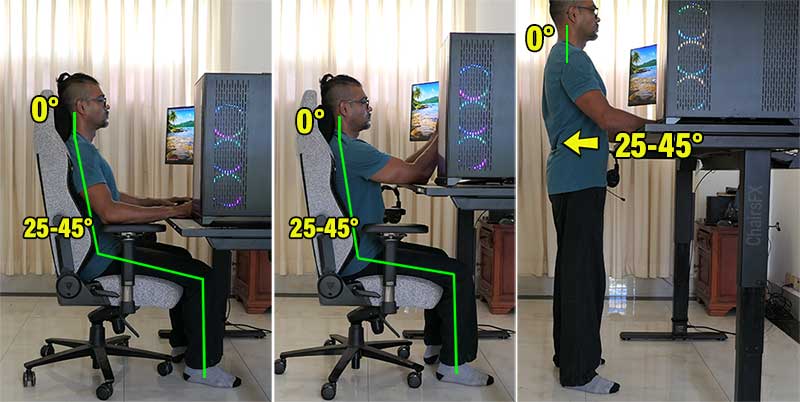
After six years, I still feel unsettled every time I fire up my PC and sit or stand at my desk. Without distractions, I feel ‘trapped’ in a high-productivity zone — with no excuses to hide behind.

If that’s too scary to face, developing an office chair addiction makes a perfect diversion. For instance, u/micromushe has been milking chair excuses for 2+ years, with no end in sight.
AI Job Losses Vs Chair Obsessions
Obsessing about chair ergonomics in 2023 is like a kid fussing with pencils before a math test. For one thing, ergonomic sitting science peaked in the 1990s — it’s old news. For another, this year’s rollout of consumer AI tools precedes an emerging Internet of Things (IoT).

As legacy jobs fall into irrelevance, new opportunities will emerge. Alvin Toffler’s Third Wave predicts that those who best embrace disruption will rise to a new ‘prosumer’ class. In contrast, those who fail to adapt will fall down into a ‘useless, unemployable’ class.

Getting sidetracked with an ergonomic chair obsession won’t help you to adapt. In sharp contrast, getting neutral postures internalized will help a tremendous amount.
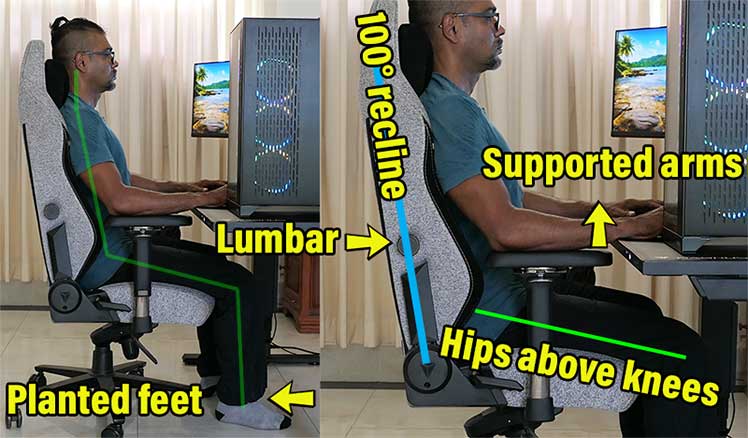
Executive functions exist in the prefrontal cortex. This is the brain’s ‘command center’. It controls mental processes like self-discipline, working memory, focus on a task, and lateral thinking.

Good posture relieves muscles, leaving more energy for the brain. With more energy, executive function abilities are more potent. The reverse is also true.
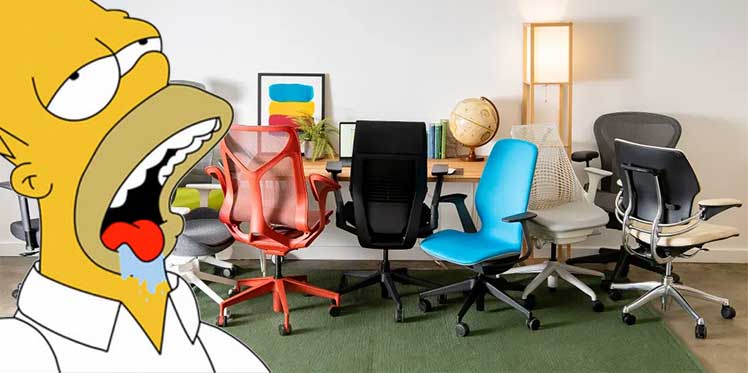
If you avoid good posture to prolong a chair addiction, you won’t gain the benefit of an energized brain. As a result, you’ll find it harder and harder to keep up as AI-powered tools creep into all facets of desk working life.
ChairsFX Advice: Get Equipped Quickly!
Sitting with a neutral posture is easy in any type of ergonomic chair. Plant your feet, tuck your hips, and adjust your chair to support your size.

It doesn’t matter if you use a pricey chair or cheap one. Gaming and office styles also don’t matter: they all provide the same neutral sitting posture support.
Even so, hordes of posters on Reddit’s r/OfficeChairs and r/HermanMiller buy multiple chairs — yet find none of them usable.
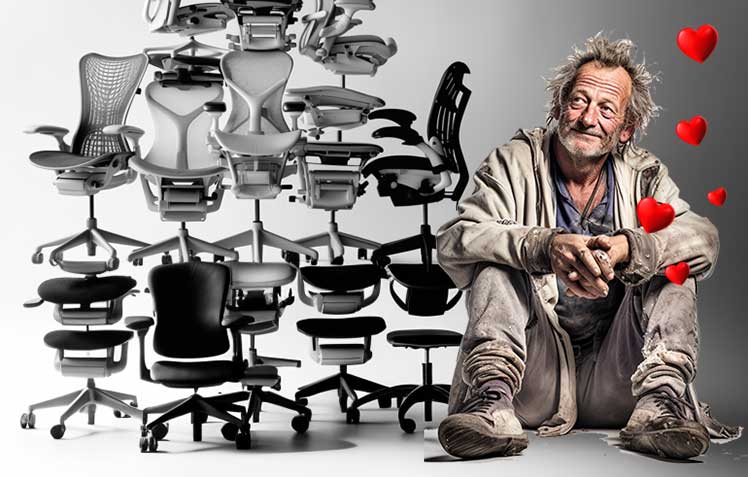
Meanwhile, the world is shifting rapidly from an industrial to AI-powered Internet of Things. In less than a year, we’ve seen copywriting, graphic design, narration, social media marketing, and many other industries be rendered irrelevant.
Instead of scrambling from one pricey office chair to the next, break your addiction with reality:
- Neutral posture objective: the end goal, regardless of chair. Mastering this technique makes ANY chair usable.
- Components trio: all ergo chairs support neutral postures using the same 3 components (it’s not complicated).
- Cheap chairs for beginners: don’t overspend on complex chairs until you know what you’re doing. Cheap, simple chairs work well for first-time ergo chair users.
- Pain isn’t chair-related: improper usage is typically the cause — not the chair. Buying more chairs won’t help.
Once you’ve mastered neutral postures, expect a surge of excess energy as an early reward. Instead of wasting that buying more chairs, you’re physically and mentally equipped for more lucrative challenges.

As the fast-emerging Internet of Things, you’ll have more energy, sharper focus, and greater flexibility. While other addicts buy more chairs, you’ll break free to seize great opportunities.
IoT Era Will Force Big Sedentary to Active Lifestyle Shift
Footnotes
- Susan Weinschenk Ph.D. ‘Shopping, Dopamine, and Anticipation’. Psychology Today, October 22, 2015. https://www.psychologytoday.com/us/blog/brain-wise/201510/shopping-dopamine-and-anticipation, (accessed 10 July, 2023).
- Mark D. Griffiths Ph.D. ‘Are You ‘Addicted’ to Chaos?’ Addiction, March 17, 2016. https://www.psychologytoday.com/us/blog/in-excess/201603/are-you-addicted-to-chaos, (accessed 10 July, 2023).
- Hendrie Weisinger Ph.D. ‘Pressure Anxiety: A Contemporary Plague’. Anxiety, March 29, 2015. https://www.psychologytoday.com/intl/blog/thicken-your-skin/201503/pressure-anxiety-a-contemporary-plague, (accessed 10 July, 2023).
Anil Ramsey
I'm the ChairsFX founder and Chief Editor. I'm a member of the OSHA Education Center Association (OECA), with an OSHA Ergonomics Certification. Beyond these credentials, I've been hands-on testing the world's finest ergonomic desk chairs since 2018. Learn more about me and this website on the About Us page.
Gaming chair trends, reviews, advice.





